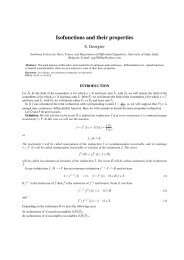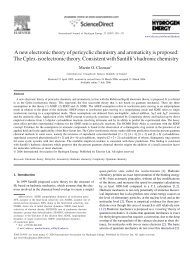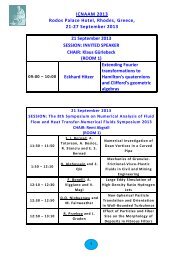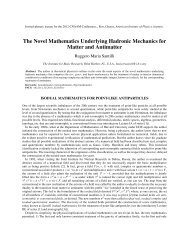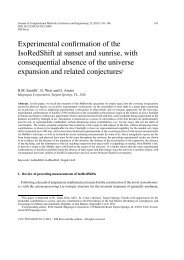The Magnehydrogen in hadronic Chemistry - The RM Santilli ...
The Magnehydrogen in hadronic Chemistry - The RM Santilli ...
The Magnehydrogen in hadronic Chemistry - The RM Santilli ...
You also want an ePaper? Increase the reach of your titles
YUMPU automatically turns print PDFs into web optimized ePapers that Google loves.
<strong>The</strong> magnehydrogen <strong>in</strong> <strong>hadronic</strong> chemistry<br />
Sangesh P. Zodape and Anil A. Bhalekar<br />
Citation: AIP Conference Proceed<strong>in</strong>gs 1558, 648 (2013); doi: 10.1063/1.4825575<br />
View onl<strong>in</strong>e: http://dx.doi.org/10.1063/1.4825575<br />
View Table of Contents: http://scitation.aip.org/content/aip/proceed<strong>in</strong>g/aipcp/1558?ver=pdfcov<br />
Published by the AIP Publish<strong>in</strong>g<br />
This article is copyrighted as <strong>in</strong>dicated <strong>in</strong> the abstract. Reuse of AIP content is subject to the terms at: http://scitation.aip.org/termsconditions. Downloaded to IP:<br />
115.240.29.218 On: Thu, 14 Nov 2013 02:45:15
<strong>The</strong> <strong>Magnehydrogen</strong> <strong>in</strong> Hadronic <strong>Chemistry</strong> 1<br />
Sangesh P. Zodape *2 and Anil A. Bhalekar **<br />
* Department of <strong>Chemistry</strong>, Visvesvaraya National Institute of Technology, Nagpur – 440 010, India<br />
E-mail: sangesh02@gmail.com<br />
** Department of <strong>Chemistry</strong>, R. T. M. Nagpur University, Amravati Road Campus, Nagpur – 440 033, India<br />
E-mail: anabha@hotmail.com<br />
Abstract. In this paper we have described <strong>in</strong> brief one of the great achievements accomplished by the Italian-American<br />
scientist Ruggero Maria <strong>Santilli</strong> [1], namely the isochemical model and magnehydrogen that form the subject matter of<br />
the <strong>hadronic</strong> <strong>Chemistry</strong>. This new chemical species of magnehydrogen consist of <strong>in</strong>dividual hydrogen atom bonded<br />
together and form stable clusters under a new <strong>in</strong>ternal attractive forces orig<strong>in</strong>at<strong>in</strong>g from the toroidal polarization of<br />
orbitals of atomic electrons when placed <strong>in</strong> strong magnetic fields. <strong>The</strong>se magnecules are used as pollution free fuel and<br />
for other applications because there is no crack<strong>in</strong>g <strong>in</strong>volved while us<strong>in</strong>g the stored magnetic energy.<br />
Keywords: <strong>Magnehydrogen</strong>, magnecules and <strong>hadronic</strong> <strong>Chemistry</strong>.<br />
PACS: 21.10Dr<br />
INTRODUCTION<br />
In the late seventeenth century, Issac Newton discovered classical mechanics, the laws of motion of macroscopic<br />
objects. In the early twentieth century, physicists found that classical mechanics does not correctly describe the<br />
behavior of very small particles. Such particles are described by a set of laws called quantum mechanics [2,3].<br />
Quantum mechanics is the science of motion of micro (atomic and subatomic) particles. Its study is of great<br />
importance <strong>in</strong> chemistry because physicochemical properties of atoms and molecules, their structures, spectral<br />
behavior and even reactions may be <strong>in</strong>terpreted <strong>in</strong> terms of the motion of micro particles like electron and protons<br />
[2,3]. Despite undeniable achievements, quantum chemical models of molecular structures have the follow<strong>in</strong>g<br />
fundamental <strong>in</strong>sufficiencies [4]:<br />
1. Lack of a sufficiently strong b<strong>in</strong>d<strong>in</strong>g force: as it is well known, the average of all coulomb forces among<br />
the atoms constitut<strong>in</strong>g a molecule is identically null at the semi classical level, thus result<strong>in</strong>g <strong>in</strong> the<br />
absence of any attractive force at all. Quantum mechanics cannot characterize an attractive force among<br />
neutral atoms of a Hydrogen molecule.<br />
2. Quantum mechanics cannot expla<strong>in</strong> why the Hydrogen and water molecules admit only two H-atoms<br />
and not three or more.<br />
3. Quantum <strong>Chemistry</strong> has been unable to achieve an exact representation of molecular b<strong>in</strong>d<strong>in</strong>g energies<br />
and other molecular characteristics via un-adulterated axiomatic pr<strong>in</strong>ciples. Electric and magnetic dipole<br />
and multi-pole moments of Hydrogen and other molecules have not been represented accurately by<br />
quantum <strong>Chemistry</strong>.<br />
4. More accurate representation of b<strong>in</strong>d<strong>in</strong>g energies violates basic quantum axioms and physical laws. A<br />
number of attempts have been conducted, which do <strong>in</strong>deed achieve a more accurate representation of<br />
b<strong>in</strong>d<strong>in</strong>g energies, although such representation is reached via a number of mathematical schemes, such<br />
as the so-called Gaussian screen<strong>in</strong>g of the Coulomb potentials. <strong>The</strong>se schemes imply a necessary<br />
violation of quantum axioms and physical laws.<br />
5. Quantum <strong>Chemistry</strong> cannot provide a mean<strong>in</strong>gful representation of thermodynamic properties. <strong>The</strong><br />
miss<strong>in</strong>g 2% <strong>in</strong> the representation of b<strong>in</strong>d<strong>in</strong>g energies is mislead<strong>in</strong>gly small, because it corresponds to<br />
about 1,000 Kcal/mole while an ord<strong>in</strong>ary thermo-dynamical reaction implies an average of 20<br />
Kcal/mole. No scientific calculation can be conducted when the error factor of the order of 50.<br />
6. Computer usages <strong>in</strong> quantum chemical calculations require excessively long period of time. This is<br />
notoriously due to the slow convergence of conventional quantum series, a feature that persists to this<br />
day despite the availability of powerful computers.<br />
1<br />
2<br />
This work is be<strong>in</strong>g presented at ICNAAM 2013 be<strong>in</strong>g held at Rhodes, Greece dur<strong>in</strong>g September 21 – 27, 2013.<br />
Correspond<strong>in</strong>g author.<br />
11th International Conference of Numerical Analysis and Applied Mathematics 2013<br />
AIP Conf. Proc. 1558, 648-651 (2013); doi: 10.1063/1.4825575<br />
© 2013 AIP Publish<strong>in</strong>g LLC 978-0-7354-1184-5/$30.00<br />
648<br />
This article is copyrighted as <strong>in</strong>dicated <strong>in</strong> the abstract. Reuse of AIP content is subject to the terms at: http://scitation.aip.org/termsconditions. Downloaded to IP:<br />
115.240.29.218 On: Thu, 14 Nov 2013 02:45:15
7. Quantum <strong>Chemistry</strong> predicts that all molecules are ferromagnetic. This <strong>in</strong>consistence of the most<br />
rigorous discipl<strong>in</strong>es of this century, Quantum electrodynamics, which establishes that, under an external<br />
magnetic field, the orbits of valence electrons must be polarized <strong>in</strong> such a way to offer magnetic<br />
polarity opposite to that of the external field (polarization that generally occurs via the transition from<br />
space to toroidal distribution of the orbitals).<br />
As it is well known, the <strong>in</strong>dividual atoms of a molecule preserve their <strong>in</strong>dividuality <strong>in</strong> the current model of<br />
chemical bonds. As a result, quantum electrodynamics predicts that the valence electrons of the <strong>in</strong>dividual atoms of<br />
a molecular bond must acquire polarized orbits under an external magnetic field. As a result, Quantum <strong>Chemistry</strong><br />
predicts that the application of an external magnetic field South-North, to hydrogen H-H, water H-O-H and other<br />
molecules implies their acquisition of the net total, opposite polarity North-South, H -H , H -O -H , etc., which is <strong>in</strong><br />
dramatic disagreement with experimental evidence.<br />
A most important <strong>in</strong>sufficiency is the <strong>in</strong>ability to represent deep mutual penetrations of the wave packets of<br />
valence electrons <strong>in</strong> molecular bonds. <strong>The</strong> latter <strong>in</strong>teractions are known to be:<br />
Nonl<strong>in</strong>ear: - i.e., dependent on powers of the wave functions greater than one;<br />
Nonlocal –<strong>in</strong>tegral: - i.e., dependent on <strong>in</strong>tegrals over the volume of overlapp<strong>in</strong>g, which, as such cannot<br />
reduced to a f<strong>in</strong>ite set of isolated po<strong>in</strong>ts; and<br />
Non-potential: - i.e., consist<strong>in</strong>g of contact <strong>in</strong>teractions with consequential zero range for which the<br />
notion of potential energy has no mathematical or physical sense.<br />
Non-Hamiltonian: - i.e. not representable via a Hamiltonian, thus requir<strong>in</strong>g additional terms and<br />
consequently<br />
Non-Unitary: - i.e. the time evolution violates unitary condition U × U † = U † × U = I.<br />
Notice that the condition of non-unitarity is necessary otherwise one would fall back fully with<strong>in</strong> the basic<br />
axioms of quantum chemistry (under the unitary representations). To overcome the above said <strong>in</strong>sufficiency there<br />
evolved Hadronic <strong>Chemistry</strong>. <strong>The</strong> Italian-American scientist Ruggero Maria <strong>Santilli</strong> has achieved a milestone <strong>in</strong><br />
formulat<strong>in</strong>g a new mathematics (hereon referred to as <strong>Santilli</strong>’s Mathematics) that streaml<strong>in</strong>ed various branches of<br />
physics <strong>in</strong>clud<strong>in</strong>g quantum mechanics. To remove these fallacies <strong>Santilli</strong> has formulated new mathematics and<br />
<strong>hadronic</strong> mechanics. Hadronic mechanics is characterized by novel iso-, geno- and hyper mathematics for the<br />
representation of reversible, irreversible and multi valued system respectively with Hamiltonian and non-<br />
Hamiltonian effects [1]. Accord<strong>in</strong>gly, the <strong>hadronic</strong> mechanics has three correspond<strong>in</strong>g branches, isomechanics,<br />
genomechanics and hyper mechanics and their isoduals. Hadronic chemistry is applicable at distances of about 1 fm<br />
(10 -13 cm) or less. As it is well known that, all fundamental particles with f<strong>in</strong>ite mass have wave packets of the order<br />
of 1 fm hence the process of molecular b<strong>in</strong>d<strong>in</strong>g is a case of <strong>in</strong>terior <strong>in</strong>teractions of these wave packets [5-8].<br />
Most of the environmental pollution is caused by fossil fuel is due to chunks (dimers) of un-combusted fuel that<br />
may be carc<strong>in</strong>ogenic primarily because consist<strong>in</strong>g of <strong>in</strong>complete combustion of fuel. <strong>The</strong>refore, <strong>Santilli</strong> has<br />
proposed and synthesized a new chemical species called as magnecules under strong magnetic field [5]. <strong>Santilli</strong>’s<br />
magnecules are <strong>in</strong> gaseous, liquid and solid states consist of stable clusters composed of conventional molecule or<br />
dimers with <strong>in</strong>dividuals atoms bonded together by oppos<strong>in</strong>g magnetic polarities of toroidal polarization of the orbit<br />
of at least the peripheral atomic electrons when exposed to sufficiently strong external magnetic fields, as well as the<br />
polarization of the <strong>in</strong>tr<strong>in</strong>sic magnetic moment of nuclei and electrons [1,4-8]. A population of magnecules<br />
constitutes a chemical species when essentially pure i.e. when molecules or other species are conta<strong>in</strong>ed <strong>in</strong> very small<br />
percentages <strong>in</strong> a directly identifiable form.<br />
In this paper we discuss magnehydrogen <strong>in</strong> <strong>hadronic</strong> chemistry. This new chemical species of magnehydrogen<br />
consist of <strong>in</strong>dividual hydrogen atom bonded together and form stable clusters under a new <strong>in</strong>ternal attractive forces<br />
orig<strong>in</strong>at<strong>in</strong>g from the toroidal polarization of orbital’s of atomic electrons when placed <strong>in</strong> strong magnetic fields.<br />
<strong>The</strong>se magnecules are used as pollution free fuel and for other applications because there is no crack<strong>in</strong>g <strong>in</strong>volved<br />
while us<strong>in</strong>g the stored magnetic energy.<br />
ISOCHEMICAL MODEL<br />
<strong>Santilli</strong> and Shillady [7] developed an isochemical model of valence bond consider<strong>in</strong>g deep overlapp<strong>in</strong>g of the<br />
wave packets of the bond form<strong>in</strong>g valence electrons and obviously the <strong>in</strong>teractions at 1 fm level of considerations<br />
requir<strong>in</strong>g hav<strong>in</strong>g the property nonlocal, non-l<strong>in</strong>ear, non-potential, non-Hamiltonion and hence non-unitary<br />
transformations. <strong>The</strong> deep overlapped s<strong>in</strong>glet state of electrons is termed by <strong>Santilli</strong> as isoelectronium because the<br />
energetic description of it requires his isomathematics [3-5]. Its pictorial representation for hydrogen molecule is<br />
depicted <strong>in</strong> Figure 1 below. This branch is known as <strong>hadronic</strong> chemistry [4].<br />
649<br />
This article is copyrighted as <strong>in</strong>dicated <strong>in</strong> the abstract. Reuse of AIP content is subject to the terms at: http://scitation.aip.org/termsconditions. Downloaded to IP:<br />
115.240.29.218 On: Thu, 14 Nov 2013 02:45:15
(a)<br />
(b)<br />
FIGURE 1. (a) Isoelectronium composed of two valence electrons <strong>in</strong> s<strong>in</strong>glet coupl<strong>in</strong>g and (b) oo-shaped orbit of isoelectronium<br />
<strong>in</strong> hydrogen molecule and dimensions of isoelectronium.<br />
<strong>The</strong> ma<strong>in</strong> features of the isochemical model are:<br />
1. Exact representation of molecular b<strong>in</strong>d<strong>in</strong>g energies from rst axiomatic pr<strong>in</strong>ciples without ad hoc<br />
adulteration.<br />
2. An explanation for why Hydrogen molecule have only two Hydrogen atoms.<br />
3. Reconstruction of the superposition pr<strong>in</strong>ciple at the isotopic level, thus permitt<strong>in</strong>g an axiomatically<br />
consistent study of composite systems under non-l<strong>in</strong>ear, non-local and non-Hamiltonian <strong>in</strong>teractions.<br />
This is achieved by embedd<strong>in</strong>g of all non-l<strong>in</strong>ear terms <strong>in</strong> the isotopic element.<br />
4. Reduction of computer time by at least 1000-fold. This is permitted by the fact that the absolute value of<br />
the isounit used to compute isoelectronium energy is much bigger than one and, consequently, the<br />
isotopic element is much smaller than one, this then turns all slow convergent series <strong>in</strong>to a strong (fast)<br />
convergent form [6-8].<br />
This model as shown <strong>in</strong> Figure 1 represents motion of isoelectronium <strong>in</strong> an oo-shaped orbit and this fact lucidly<br />
help <strong>in</strong> describ<strong>in</strong>g the magnecular bond<strong>in</strong>g discussed <strong>in</strong> next section.<br />
MAGNEHYDROGEN<br />
<strong>The</strong> new species is generically denoted MH and its <strong>in</strong>dividual clusters are denoted MH n , n = 2, 3, 4, …. to<br />
specify the number of hydrogen atoms per cluster. Most of the environmental pollution is caused by fossil fuel is<br />
due to chunks (dimers) of uncombusted fuel that may be carc<strong>in</strong>ogenic primarily because consist<strong>in</strong>g of <strong>in</strong>complete<br />
combustion of fuel. <strong>The</strong>refore, <strong>Santilli</strong> has proposed and synthesized a new chemical species called as magnecules<br />
under strong magnetic field [1,4,5,9]. <strong>Santilli</strong>’s magnecules are <strong>in</strong> gaseous, liquid and solid states consist of stable<br />
clusters composed of conventional molecule or dimers with <strong>in</strong>dividuals atoms bonded together by oppos<strong>in</strong>g<br />
magnetic polarities of toroidal polarization of the orbit of at least the peripheral atomic electrons when exposed to<br />
sufficiently strong external magnetic fields, as well as the polarization of the <strong>in</strong>tr<strong>in</strong>sic magnetic moment of nucleia<br />
and electrons [1,4,5,9]. A population of magnecules constitutes a chemical species when essentially pure i.e. when<br />
molecules or other species are conta<strong>in</strong>ed <strong>in</strong> very small percentages <strong>in</strong> a directly identifiable form. To our best<br />
understand<strong>in</strong>g, the most plausible <strong>in</strong>terpretation of the new species of MH is that orig<strong>in</strong>ally presented by <strong>Santilli</strong> <strong>in</strong><br />
Ref. [9], namely, a multiple of the specific weight under a high Hydrogen percentage is evidence of a new cluster<strong>in</strong>g<br />
of H-atoms which cannot possibly be of valence type due to the evident absence of the valence electrons necessary<br />
for a quantitative representation of the cluster<strong>in</strong>g of many different atoms. <strong>The</strong>refore, <strong>Santilli</strong> presented the new<br />
species of MH as additional evidence on the existence of the new species of magnecules for <strong>Santilli</strong>’s orig<strong>in</strong>al<br />
presentations and Ref. [9] for recent experimental confirmations as well as to update the rapidly grow<strong>in</strong>g literature<br />
<strong>in</strong> the field). In essence, the new chemical species of magnecules can be def<strong>in</strong>ed as clusters of <strong>in</strong>dividual atoms (H,<br />
O, C, etc.), dimers (HO, CH, etc.) and ord<strong>in</strong>ary molecules (H 2 , CO, H 2 O, etc.) bonded together by attractive forces<br />
between oppos<strong>in</strong>g magnetic polarities of toroidal polarizations of atomic orbitals, as well as the polarization of the<br />
magnetic moments of nuclei and electrons (see a conceptual render<strong>in</strong>g of MH n <strong>in</strong> Figure 2). <strong>Santilli</strong> first developed,<br />
the so-called PlasmaArcFlow TM Reactor, that converts various liquids <strong>in</strong>to a combustible gaseous fuel known as<br />
MagneGas (MG). <strong>The</strong> gasification is achieved via a submerged DC electric arc between carbon electrodes that,<br />
under sufficient powers (of the order of 300 kW or more) is capable of produc<strong>in</strong>g at atomic distances the high values<br />
of the magnetic field necessary for the polarization of electron orbitals <strong>in</strong>to toroids (estimated as be<strong>in</strong>g of the order<br />
of 10 12 Gauss).<br />
650<br />
This article is copyrighted as <strong>in</strong>dicated <strong>in</strong> the abstract. Reuse of AIP content is subject to the terms at: http://scitation.aip.org/termsconditions. Downloaded to IP:<br />
115.240.29.218 On: Thu, 14 Nov 2013 02:45:15
(a) (b) (c) (d)<br />
Figure 2: Conceptual render<strong>in</strong>g of <strong>Santilli</strong>’s magnecules. (a) Magnehydgrogen (MH), two hydrogen atoms form<strong>in</strong>g a magnecule<br />
MH 2 (H×H), (b) A cluster MH 2 <strong>in</strong> MH composed of H-H and H×H molecules, (c) A cluster MH 3 <strong>in</strong> MH composed of the<br />
magnecular species H-H×H and H×H×H, (d) A cluster of MH 4 <strong>in</strong> MH composed of the magnecular species H×H×H×H and H-<br />
H×H-H (not shown species is H-H×H×H).<br />
ENERGETICS OF MAGNECULES<br />
<strong>The</strong> calculation of these polarized magnetic moments at absolute zero degree temperature is elementary [10]. By<br />
us<strong>in</strong>g rationalized units, the magnetic moment M<br />
e-orb. of a polarized orbit of one atomic electron is given by the<br />
general quantum mechanical law:<br />
Me-orb. ( q/2 m) L ,<br />
(1)<br />
where L is the angular momentum, is the rationalized unit of magnetic moment of the electron, q = -e and m = m e .<br />
Now on follow<strong>in</strong>g steps described by <strong>Santilli</strong> [11] we obta<strong>in</strong>,<br />
M M 1,856.959 , ( M<br />
e-orb. isoelectronium-orb. e-orb.<br />
/ M<br />
p-<strong>in</strong>tr.<br />
) 1,856.959 /1.4107 1,316.33 (2)<br />
where we have used magnetic moment of proton equal to 1.4107 . Thus it shows that the magnetic moment<br />
created by the orbit<strong>in</strong>g <strong>in</strong> a plane of the electron <strong>in</strong> the hydrogen atom is 1,316 times bigger than the <strong>in</strong>tr<strong>in</strong>sic<br />
magnetic moment of the nucleus, thus be<strong>in</strong>g sufficiently strong to create a bond. Say at 10 Tesla of magnetic field<br />
the magnecular bond has a strength of about 20-25 kcal/mol [12].<br />
CONCLUSIONS<br />
In preced<strong>in</strong>g sections, we have described <strong>in</strong> brief the physical and mathematical background of <strong>Santilli</strong>’s<br />
cover<strong>in</strong>g of quantum chemistry known as <strong>hadronic</strong> chemistry. <strong>The</strong> aspects those covered <strong>in</strong> brief here<strong>in</strong> are the<br />
isochemical model of valence bond formation, basics of magnecular <strong>in</strong>teractions, some aspects of magnehydrogen<br />
and its energetic. <strong>The</strong> magnecules are pollution free fuels because it provides stored magnetic energy without<br />
molecular crack<strong>in</strong>g.<br />
ACKNOWLEDGMENTS<br />
<strong>The</strong> authors would like to thank Professor R. M. <strong>Santilli</strong> for guidance and encouragements without which this<br />
paper would not have seen the light of the day. This work is supported by the R. M. <strong>Santilli</strong> Foundation, Palm<br />
Harbor, Florida, USA.<br />
REFERENCES<br />
1. I. Gandzha and J. Kadeisvily, New Sciences for a New Era. Mathematical, Physical Discoveries of Ruggero Maria Santill,<br />
Sankata Pr<strong>in</strong>t<strong>in</strong>g Press, Kathmandu, Nepal, 2011.<br />
2. I. N. Lev<strong>in</strong>e, Quantum chemistry, Pearson Education, Limited 2008.<br />
3. R. K. Prasad, Quantum chemistry, New Age International, 2006.<br />
4. R. M. <strong>Santilli</strong>, Foundations of Hadronic <strong>Chemistry</strong>, With Applications to New Clean Energies and Fuels, Kluwer Academic<br />
Publishers, Dordrecht, <strong>The</strong> Netherlands, 2001.<br />
5. R. M. <strong>Santilli</strong>, Hadronic Mathematics, Mechanics and <strong>Chemistry</strong>, Vol. V, International Academic Press, Palm Harbor, FL,<br />
2008.<br />
6. R. M. <strong>Santilli</strong>, Int. J. Hydrogen Energy, 28 (2003) 177-196.<br />
7. R. M. <strong>Santilli</strong> and D. D. Shillady Int. J. Hydrogen Energy, 24, (1999) 943-956; 25, (2000) 173-183.<br />
8. V. M. Tangde, AIP Conf. Proc., 1479 (2012) 1033-1036.<br />
9. Y. Yang, J.V. Kadeisvili and S. Marton, Int. J. Hydrogen Energy, 38 (2013) 5003-5008.<br />
10. R. M. <strong>Santilli</strong>, Hadronic J., 21 (1998) 789-894.<br />
11. R. M. <strong>Santilli</strong>, <strong>The</strong> New Fuels with Magnecular Structure, International Academic Press, Palm Harbor, FL 34682, U.S.A.,<br />
2005.<br />
12. R. M. <strong>Santilli</strong> and A. K. Ar<strong>in</strong>gaz<strong>in</strong>, Structure and Combustion of Magnegases TM .<br />
http://www.i-b-r.org/docs/combusweb.pdf<br />
651<br />
This article is copyrighted as <strong>in</strong>dicated <strong>in</strong> the abstract. Reuse of AIP content is subject to the terms at: http://scitation.aip.org/termsconditions. Downloaded to IP:<br />
115.240.29.218 On: Thu, 14 Nov 2013 02:45:15



